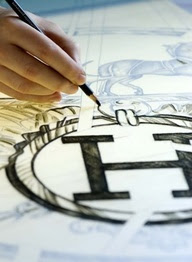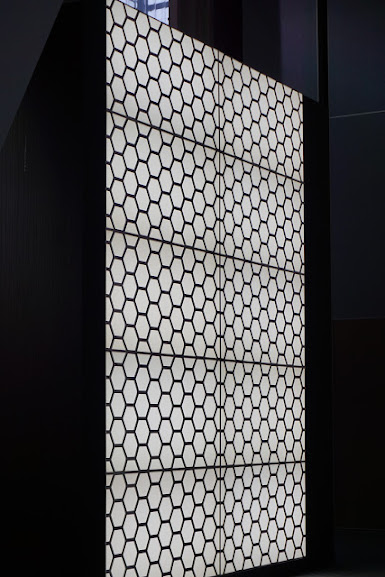Friday's Why In Design: The ancient art of Batik and where to find the best examples of the designs in today's interior design market
 Batik (/ˈbætɪk/ or /bəˈtiːk/; Javanese pronunciation: [ˈbateʔ];Indonesian: [ˈbatɪk]) is a cloth that is traditionally made using a manual wax-resist dyeing technique.
Batik (/ˈbætɪk/ or /bəˈtiːk/; Javanese pronunciation: [ˈbateʔ];Indonesian: [ˈbatɪk]) is a cloth that is traditionally made using a manual wax-resist dyeing technique.
THE HISTORY of BATIK
Derived from the Javanese word “tritik” which means tying and sewing parts of the textile before dying, or “Ambatik” which means cloth with little dots, Batik can be traced back to the early Egyptian tombs, and then throughout the Middle East. The fabric design was seen in the 17th Century in Holland and other European countries, however, it didn’t become popular until the 19th Century when the tribesmen of small villages in Malaysia and Indonesia perfected this art form as a way to create textiles for families to differentiate social standing and geographic regions. It became a way to distinguish a family’s social status, depending upon which pattern and styles were chosen. It is important to note that in Indonesia specific patterns were intended to be worn only by nobility, like the wider stripes and wavy deep lines. Traditional colors include indigo, dark brown, and white representing the three major Hindu Gods -- Brahma, Vishnu and Siva. This was devised so that during traditional Javanese ceremonies, it was clear who was royalty and who was not. By the early 1900s Batik fabric was fashionable in Germany and other parts of Europe, and eventually it came to the States where it continues to hold timeless appeal in our fashion and interior design.
Derived from the Javanese word “tritik” which means tying and sewing parts of the textile before dying, or “Ambatik” which means cloth with little dots, Batik can be traced back to the early Egyptian tombs, and then throughout the Middle East. The fabric design was seen in the 17th Century in Holland and other European countries, however, it didn’t become popular until the 19th Century when the tribesmen of small villages in Malaysia and Indonesia perfected this art form as a way to create textiles for families to differentiate social standing and geographic regions. It became a way to distinguish a family’s social status, depending upon which pattern and styles were chosen. It is important to note that in Indonesia specific patterns were intended to be worn only by nobility, like the wider stripes and wavy deep lines. Traditional colors include indigo, dark brown, and white representing the three major Hindu Gods -- Brahma, Vishnu and Siva. This was devised so that during traditional Javanese ceremonies, it was clear who was royalty and who was not. By the early 1900s Batik fabric was fashionable in Germany and other parts of Europe, and eventually it came to the States where it continues to hold timeless appeal in our fashion and interior design.

WHAT IS IT?
It is a technique of waxing and dyeing fabric onto cotton cloth with colorfast fabrics. Although it is similar to a tie dye technique it is a more complicated process. It is often hand drawn. A finer process of Batik called tulis batiks is when the artist uses their hands and a canting tool to create the design. Canting is a small pen like copper cup with a well for wax. First, the artist melts Beeswax in a metal flamed pot set underneath the canting tool then draws a design onto the cotton. The fabric is secured onto a frame and the wax melts with the artist dripping then applying the wax to the cloth to outline the pencil drawing. Once complete the first color dye is poured on. A second coat of wax is applied and working from lighter colors to dark colors the color layering is created. Next, the cotton is placed in boiling water to melt the wax off and once the wax is off the original color of the fabric creates the designs contrasted against the added colors as a background. The precision of the process and using the wax makes the design permanent and often there are small imperfections, but I like this finished aesthetic which gives off a bohemian, beach-like feel, perfect for a summer cottage or a relaxed sophisticated environment. Often in today's fabrics named Batik some are printed to look like the originally handmade version.
See a sampling of my favorite Batik-style fabrics...
Kathryn Ireland's stunning designs
are fresh and modern feeling.
She gives us the feel of Batik and in a lovely color palette and patterns.
John Robshaw's designs are rich in detail and color.
Here in John Robshaw's downtown Manhattan studio
we see an eclectic array of his exotic fabrics, Batiks included and from all over the world.
John has studied the art of creating Batik and sells his inspired art pieces over at One Kings Lane
"This beautiful work gives an up-close look at the intricacies of batik designs. John Robshaw began working with wax stamps in Yogyakarta, in Indonesia, and his designs are inspired by the local myths and volcanoes of the region."
~~One Kings Lane

~~One Kings Lane

Quadrille fabrics has been one of the leaders in keeping Batik popular in today's design industry.
I love this stunning and inviting table -- my kind of dinner party -- both formal and informal all at the same time, and with beautiful rich wood, colors and textiles. The Batik fabric on the curtains is from Quadrille and the large pattern anchors the space, setting the tone. From the pages of House Beautiful, we get to see many of the details of designers John Knott and John Fondas' project where they transformed an old hotel in Maine. It has a Yankee American appeal, yet through layering fabrics, textures and wallpaper from all over the world they achieved this aesthetic. They used Batik in many of the rooms.
I love the use of Batik in the living room of this project -- and the blue and orange color combination works well against all the wood.
another beautiful room, and the blue and orange story continues (Quadrille fabric Batik on chair and pillows)
from this Maine project.
And, last, but certainly not least let me show you a brand new Batik-inspired fabric collection on the design horizon...
Here is a special sneak-peek of Batik-inspired cushions and throws hot off the press and ready to make their debut. Created by two illustrious designers joining forces; Bunny Williams and Annie Selke have teamed up to bring both of their design sensibilities and talents for an indoor/outdoor rug collection as well as "antique Batik" inspired throws and cushions called Bunny Williams for Dash & Albert. I stopped into Bunny's shop, Treillage, which is a hidden gem on the Upper East Side and tucked into a quiet area of 75th Street. It is a perfect respite for those who love gardening, art, antiques, interior design, textiles, accessories and furniture, and has been one of my very favorite design shops for almost two decades. Each and every time I visit Treillage it is transformed into something new and fantastical. Today it was a Batik wonderland of sorts with their new designs woven into the shop's vignettes throughout and on the walls, and draped on furniture. Come take a look at the gorgeous Batik-inspired designs.Bunny Williams and Annie Selke
these textiles have a softness and unusual quality, but with the familiarity of Batik, they feel fresh and new with a nod to history.
Please stop back on Monday for the "inside scoop" on Bunny and Annie's fabulous indoor/outdoor rug collection!
Happy NestingXO Tamara
sources:
my Pinterest Batik Board for more photos and sources
























